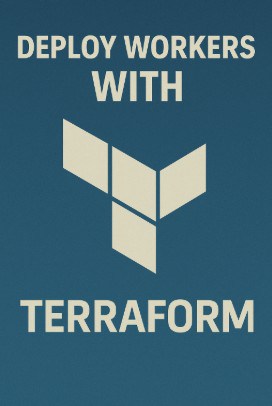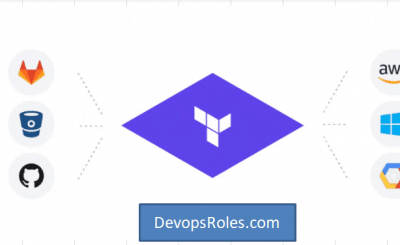In today’s fast-paced world of software development and deployment, efficiency and automation are paramount. Infrastructure as Code (IaC) tools like Terraform have revolutionized how we manage and deploy infrastructure. This guide delves into the powerful combination of Cloudflare Workers and Terraform, showing you how to seamlessly deploy and manage your Workers using this robust IaC tool. We’ll cover everything from basic deployments to advanced scenarios, ensuring you have a firm grasp on this essential skill.
Table of Contents
- 1 What are Cloudflare Workers?
- 2 Why Use Terraform for Deploying Workers?
- 3 Setting Up Your Environment
- 4 Basic Worker Deployment with Terraform
- 5 Advanced Worker Deployment Scenarios
- 6 Real-World Use Cases
- 7 Frequently Asked Questions (FAQ)
- 7.1 1. Can I use Terraform to manage Worker KV (Key-Value) stores?
- 7.2 2. How do I handle secrets in my Terraform configuration for Worker deployments?
- 7.3 3. What happens if my Worker script has an error?
- 7.4 4. How can I integrate Terraform with my CI/CD pipeline?
- 7.5 5. What are the limitations of using Terraform for Cloudflare Workers?
- 8 Conclusion Deploy Cloudflare Workers with Terraform
What are Cloudflare Workers?
Cloudflare Workers are a serverless platform that allows developers to run JavaScript code at the edge of Cloudflare’s network. This means your code is executed incredibly close to your users, resulting in faster loading times and improved performance. Workers are incredibly versatile, enabling you to create APIs, build microservices, and implement various functionalities without managing servers.
Why Use Terraform for Deploying Workers?
Manually managing Cloudflare Workers can become cumbersome, especially as the number of Workers and their configurations grow. Terraform provides a solution by allowing you to define your infrastructure-in this case, your Workers—as code. This approach offers numerous advantages:
- Automation: Automate the entire deployment process, from creating Workers to configuring their settings.
- Version Control: Track changes to your Worker configurations using Git, enabling easy rollback and collaboration.
- Consistency: Ensure consistent deployments across different environments (development, staging, production).
- Repeatability: Easily recreate your infrastructure from scratch.
- Collaboration: Facilitates teamwork and simplifies the handoff between developers and operations teams.
Setting Up Your Environment
Before we begin, ensure you have the following:
- Terraform installed: Download and install Terraform from the official website: https://www.terraform.io/downloads.html
- Cloudflare Account: You’ll need a Cloudflare account and a zone configured.
- Cloudflare API Token: Generate an API token with the appropriate permissions (Workers management) from your Cloudflare account.
Basic Worker Deployment with Terraform
Let’s start with a simple example. This Terraform configuration creates a basic “Hello, World!” Worker:
terraform {
required_providers {
cloudflare = {
source = "cloudflare/cloudflare"
version = "~> 2.0"
}
}
}
provider "cloudflare" {
api_token = "YOUR_CLOUDFLARE_API_TOKEN"
}
resource "cloudflare_worker" "hello_world" {
name = "hello-world"
script = "addEventListener('fetch', event => { event.respondWith(new Response('Hello, World!')); });"
}
Explanation:
provider "cloudflare": Defines the Cloudflare provider and your API token.resource "cloudflare_worker": Creates a new Worker resource.name: Sets the name of the Worker.script: Contains the JavaScript code for the Worker.
To deploy this Worker:
- Save the code as
main.tf. - Run
terraform initto initialize the providers. - Run
terraform planto preview the changes. - Run
terraform applyto deploy the Worker.
Advanced Worker Deployment Scenarios
Using Environment Variables
Workers often require environment variables. Terraform allows you to manage these efficiently:
resource "cloudflare_worker_script" "my_worker" {
name = "my-worker"
script = <<-EOF
addEventListener('fetch', event => {
const apiKey = ENV.API_KEY;
// ... use apiKey ...
});
EOF
environment_variables = {
API_KEY = "your_actual_api_key"
}
}Managing Worker Routes
You can use Terraform to define routes for your Workers:
resource "cloudflare_worker_route" "my_route" {
pattern = "/api/*"
service_id = cloudflare_worker.my_worker.id
}
Deploying Multiple Workers
You can easily deploy multiple Workers within the same Terraform configuration:
resource "cloudflare_worker" "worker1" {
name = "worker1"
script = "/* Worker 1 script */"
}
resource "cloudflare_worker" "worker2" {
name = "worker2"
script = "/* Worker 2 script */"
}Real-World Use Cases
- API Gateway: Create a serverless API gateway using Workers, managed by Terraform for automated deployment and updates.
- Microservices: Deploy individual microservices as Workers, simplifying scaling and maintenance.
- Static Site Generation: Combine Workers with a CDN for fast and efficient static site hosting, all orchestrated through Terraform.
- Authentication and Authorization: Implement authentication and authorization layers using Workers managed by Terraform.
- Image Optimization: Build a Worker to optimize images on-the-fly, improving website performance.
Frequently Asked Questions (FAQ)
1. Can I use Terraform to manage Worker KV (Key-Value) stores?
Yes, Terraform can manage Cloudflare Workers KV stores. You can create, update, and delete KV namespaces and their entries using the appropriate Cloudflare Terraform provider resources. This allows you to manage your worker’s data storage as part of your infrastructure-as-code.
2. How do I handle secrets in my Terraform configuration for Worker deployments?
Avoid hardcoding secrets directly into your main.tf file. Instead, utilize Terraform’s environment variables, or consider using a secrets management solution like HashiCorp Vault to securely store and access sensitive information. Terraform can then retrieve these secrets during deployment.
3. What happens if my Worker script has an error?
If your Worker script encounters an error, Cloudflare will log the error and your Worker might stop responding. Proper error handling within your Worker script is crucial. Terraform itself won’t directly handle runtime errors within the worker, but it facilitates re-deployment if necessary.
4. How can I integrate Terraform with my CI/CD pipeline?
Integrate Terraform into your CI/CD pipeline (e.g., Jenkins, GitLab CI, GitHub Actions) to automate the deployment process. Your pipeline can trigger Terraform commands (terraform init, terraform plan, terraform apply) on code changes, ensuring seamless and automated deployments.
5. What are the limitations of using Terraform for Cloudflare Workers?
While Terraform is highly effective for managing the infrastructure surrounding Cloudflare Workers, it doesn’t directly manage the runtime execution of the Worker itself. Debugging and monitoring still primarily rely on Cloudflare’s own tools and dashboards. Also, complex Worker configurations might require more intricate Terraform configurations, potentially increasing complexity.

Conclusion Deploy Cloudflare Workers with Terraform
Deploying Workers using Terraform offers significant advantages in managing and automating your serverless infrastructure. From basic deployments to sophisticated configurations involving environment variables, routes, and multiple Workers, Terraform provides a robust and scalable solution. By leveraging IaC principles, you can ensure consistency, repeatability, and collaboration throughout your development lifecycle. Remember to prioritize security by using appropriate secret management techniques and integrating Terraform into your CI/CD pipeline for a fully automated and efficient workflow. Thank you for reading the DevopsRoles page!
